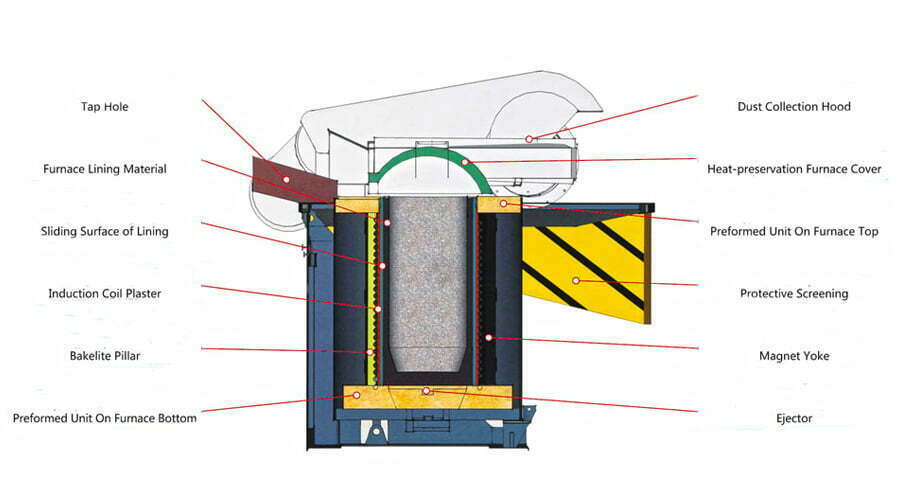Induction furnace drawing is an important design that helps communicate and confirm details before the induction heating equipment ( induction melting furnace ) is established.
Induction furnace is currently the most widely used and widely used heating equipment in the heating industry. It is not only used in forging industry, foundry industry, hot stamping industry, but also widely used in quenching, tempering and other metal quenching and tempering of heat treatment.
Features
Induction Furnace Features
An induction furnace is an electric furnace in which heat is applied by inductively heating metal. Induction furnaces range in capacity from less than one kilogram to a hundred tons and are used to smelt steel, copper, aluminum and precious metals. Advantages of induction furnaces over most other methods of melting metals are cleanliness, energy savings and a well-controlled melting process.
Most modern foundries use this type of furnace, and many iron foundries are replacing cupola furnaces with induction furnaces for melting cast iron because the former emit a lot of dust and other pollutants.
Induction furnaces do not require an electric arc (like an electric arc furnace) or combustion (like a blast furnace). The material entering the furnace is never heated above the temperature required to melt it, which prevents the loss of valuable alloying elements.
Among the many induction furnace drawing, the demand for coreless induction furnaces is more. The coreless induction furnace metal is placed in a crucible surrounded by a water-cooled AC electromagnetic coil. Channel induction furnaces have a loop of molten metal passing through an iron core to form a single-turn secondary winding.
Design
Induction furnace drawing design
An induction furnace consists of an insulated crucible containing the metal to be melted, surrounded by a ring of copper wire. A strong alternating current flows through the wire. The coil produces a rapidly opposing magnetic field that penetrates metal. The magnetic field induces eddy currents in the metal through electromagnetic induction, that is, circular currents.
Eddy currents flow through the resistance of the bulk metal, heating it through Joule heating. In ferromagnetic materials such as iron, the material may also be heated due to hysteresis (an inversion of the molecular magnetic dipoles in the metal). When melting, the vortex causes vigorous agitation of the melt to ensure better mixing.
An advantage of induction heating is that the heat is generated inside the charge of the furnace rather than by burning fuel or other external heat source, which can be important in applications where contamination is an issue.
Operating frequencies range from mains frequency (50 or 60 Hz) to 400 kHz or higher, usually depending on the material being melted, the capacity (volume) of the furnace and the desired melting rate.
Generally, the smaller the melt volume, the higher the frequency of furnace use. This is because skin depth is a measure of how far below the surface of a conductor an alternating current can penetrate.
For the same conductivity, higher frequencies have a shallower skin depth, ie less penetration into the melt. Lower frequencies create agitation or turbulence in the metal.
A preheated one-ton furnace of molten iron can melt cold charges ready for tapping within an hour. Power sources range from 10kW to 42MW with melt sizes from 20 kg to 65 tonnes of metal respectively.
An operating induction furnace will often hum or whine (due to fluctuating magnetic forces and magnetostriction), the tone of which can be used by the operator to determine if the furnace is functioning properly or the power level.
The design of the induction furnace drawing depends on the conditions of the furnace charge, output, foundry, etc. The specific plan can be further communicated with the manufacturer.
Hani Metallurgy is a professional industrial electric furnace manufacturer and powerful factory mainly producing melting furnaces. After years of development, it has become a professional manufacturer of induction metal melting furnace, intermediate frequency electric furnaces, EAF, LF, SAF, IF and other smelting equipment. It can provide users with one-stop engineering outsourcing services such as “turnkey projects”.
Welcome to continue to follow us, we will continue to share more information about metal smelting equipment. If you have any questions or needs about melting furnaces, please feel free to contact us!

